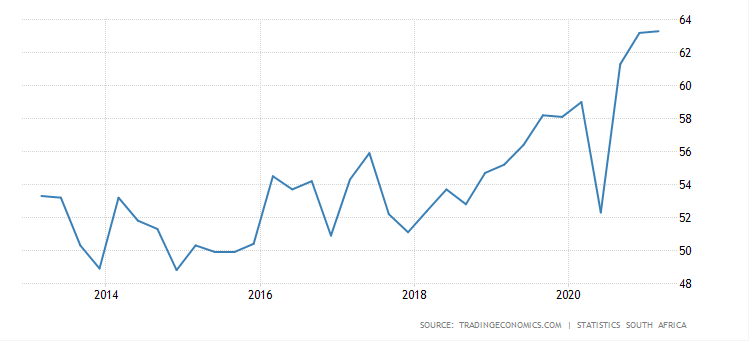Youth unemployment has long been one of South Africa’s most pressing and complex challenges, and in 2021 it only got worse.
The South African government recently shared the results of the 2021 Quarterly Labour Force Survey and it paints a bleak picture for the state of unemployment in the country, specifically amongst the youth. As of Q1 2021, the official unemployment rate among youth (15-34 years) was 46.3%.
The COVID-19 pandemic is widely understood to have negatively impacted employment opportunities for young South Africans; however, the severity of this social issue is also due to many other systemic factors, such as our broken and outdated education system, which leaves matriculating students at a disadvantage in the globally online world.

Source: StatsSA
What the president had to say
In his most recent weekly letter to the public, President Cyril Ramaphosa weighed in on the topic as he reflected on Youth Day and the role of young people in South Africa. The president claimed that the government’s current top priority is to create training and employment opportunities for young people, as well as systems of support that help them to succeed in these opportunities.
President Ramaphosa’s open letter stated:
“Everything that we do as a government contributes towards improving the lives of young people. Tackling youth unemployment requires accelerating economic growth, particularly in labour-intensive sectors, and building the capability of the state to fulfil its developmental role.”
The president’s letter addressed the Presidential Youth Employment Intervention, which reportedly began a few weeks before South Africa’s national lockdown last year and is soon to be fully implemented.
Ramaphosa wrote that:
“The Presidential Youth Employment Intervention was built on the understanding that to address the youth unemployment crisis requires innovative thinking and strong partnerships across society. Its ultimate objective is to find models that work, whether in skills development or active labour market policies, and to scale these models rapidly to reach as many young people as possible.”
“Most importantly, it recognises that young people must be at the centre of any effort to boost youth employment. Young people are our greatest asset, and our greatest weapon in this fight.”
The president outlined two Presidential Youth Employment Intervention initiatives that the government believes will help to combat youth unemployment.
- The Presidential Employment Stimulus. This is a fund that “aims to create new jobs, provide support for livelihoods and protect existing jobs in vulnerable sectors”
- A National Pathway Management Network. This is an initiative that helps young job seekers to view and access opportunities and “receive active support to find pathways into the labour market”
The untackled challenges
On paper, the Presidential Youth Employment Intervention initiatives seem to hold promise. However, they fail to address some key issues that are at the root of our youth unemployment crisis, ultimately misdiagnosing the problem. The answer to youth unemployment isn’t merely to give young people money or temporary jobs, because this ignores the fact that the systems that prepare these youth for jobs are ‘training’ them for shrinking low-skill and high-competition positions in labour or services. Instead, the President’s response should consider these key contributors to the worsening crisis:
- Outdated education systems
The unemployment crisis is deeply connected to our outdated education models. There is a disconnect between what the knowledge, skills, and training that traditional secondary and tertiary education providers offer and what the labour market and employers actually need.
According to Stats SA, “…the young work-seekers are not well educated and do not possess sufficient skills and previous work experience demanded by employers in the labour market. The economy demands skilled and experienced work-seekers, which makes it difficult and lessens the chances for young people to find employment, which ultimately results in some losing hope of ever finding a job.”
- The serious role of poverty and other social issues
Many young people who are struggling to find employment are also reckoning with other complex socio-economic factors, predominantly issues of poverty. These challenges can greatly hinder their ability to take part in necessary training and employment opportunities.
In a recent BizNews article, three researchers weigh in on this, saying that:
“Evidence repeatedly shows how many barriers and challenges young people face as they leave the education system and begin to find their way towards a job, and perhaps even a career. These barriers are not only related to the labour market or education system. They also include issues such as food insecurity, income poverty, and care responsibilities, among others. Each of these limit the ability of young people to look for work.”
- Supply versus demand
Skills and training aside, young people’s ability to find work is contingent on the availability of employment opportunities, and therefore an existing demand for employees. In essence, job placement statistics speak more to demand than supply.
On this, the same three researchers shared with BizNews that:
“A young person’s ability to find a job doesn’t depend only on their skills but also on whether the labour market is creating sufficient demand for employees. No matter how well a programme trains and supports a young person, if there are limited jobs, young people are unlikely to be employed.”
What is needed?
We don’t have all the answers, but based on the complex set of challenges that we face as a country when it comes to youth unemployment, it’s clear that what’s needed is a multidimensional approach that accounts for South Africa’s many social and economic factors.
- A fresh take on education
Young people need to receive training that has a strong practical focus, is industry aligned, and that is actively connected to relevant organisations in the public and private sectors.
- Continuous training
We need to focus not only on simply placing someone in a job, but ensuring that they are placed into a meaningful career pathway that also provides continuous training and growth opportunities. In this way, we can ensure that our workforce continues to upskill, while also having the security of employment.
- Meaningful support
It’s not enough to merely train young people and place them in a job, especially when many of them are coming from a position of poverty. Young job seekers need intensive social and financial support from both government and the private sector to ensure they can thrive in education, training and early employment.
We believe that our model of combined online education with personal mentorship and a focus on job-ready skills for an increasingly digital world are at least part of the answer to the crisis of youth unemployment. Our ability to offer accessible, affordable tech education that gets job seekers ready to work in as little as 3 months (rather than 4 years in comparable degree programs) truly empowers youth not just to find work in the rapidly growing global tech industry, but to learn transferrable, in-demand skills that set them up for a lifetime of fulfilling work and career growth.
As a tertiary education provider in South Africa, we’re committed to ensuring that we’re doing our part in solving the youth unemployment crisis in our country.
Read more about our methodology and vision here.


